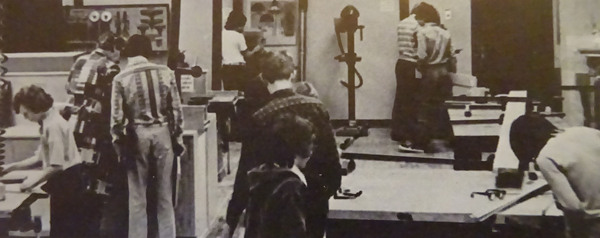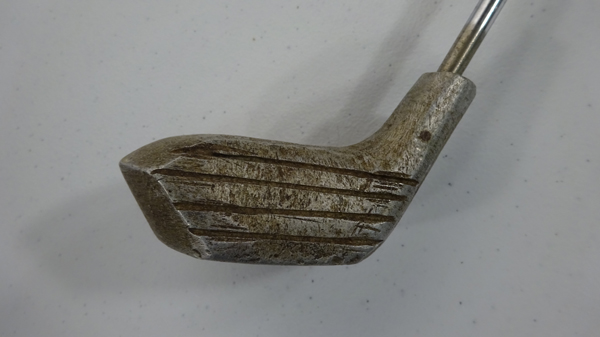JOE PERDUE
By Joe Perdue
Special to the Sports Paper
I was taking inventory at our off-course merchandise back-stock facility this afternoon (more commonly known as ‘The Ugly’ of our storage units, the other two we call ‘The Good’ and ‘The Bad’) and came across a box I didn’t recognize. Upon inspection, I found it contained several old persimmon drivers, the heads carefully wrapped to protect the wood finish from getting banged around during my move from Bremerton to Michigan in 2000.
I’m easily distracted, especially when I’m doing something I absolutely hate (I’d rather go to the dentist than take inventory. Unfortunately they were closed today), so I started digging through the box, admiring the craftsmanship and pure beauty of an era gone by in golf. Then one of the clubs I unwrapped put a big smile on my face, and I said to myself, ‘holy smokes, I can’t believe I still have this!’ It was a golf club I had made in my 8th grade shop class.
Much to my grandfather’s disappointment, I took after my dad when it came to being able to build or repair anything. ‘Handyman’ is not something that’s in my vocabulary. My solution to fixing anything was, and still is a good whack with a hammer and then lay on the duct tape. This actually serves me quite well here at our course. Everyone knows my (in)ability to fix things, so whenever something breaks, everyone else rushes to take care of it before I have a chance to make it worse.
I have my staff well-trained.
In theory, junior high shop class is designed specifically for someone like me. And to some extent, it did help. Arguably, I now know the difference between a screwdriver and a hammer. And since I still have all of my fingers, I was smart enough to never get near a table saw. But it took me a week or two to learn why I had two ears and only one mouth, and I learned the hard way to follow the teacher’s directions.
I think to pass the class you had to complete a certain number of projects in a certain number of areas of the shop class, and also had to learn how to use a minimal number of machines. Before you could use a machine, you had to demonstrate to the teacher you knew how to operate it and then have him sign you off on it. That involved reading directions and studying, not two of my strong suits when I was in 8th grade.
My first project was this wooden tie rack. It was an 8-inch long piece of wood that was about four inches wide. You drilled holes in the sides of it for dowels, screwed a hook into the top of it, and voila! I’d have something to give to my dad for his birthday. He’d also have something to hang all of those ties on that he always got for Father’s Day.
So the instructions to make this thing included learning how to use a drill press. Not wanting to go through the process to learn how to use a drill press, I decided to use a hand drill instead, since I wasn’t required to get signed off on that before being allowed to use it. After I spent several days prepping this piece of wood, I measured out where all of the holes were supposed to go and then got busy with that drill. I quickly realized there was a problem when the dowels were sticking out the side of this piece of wood at all kinds of crazy angles, and none were the same length.
After a quick lecture from Mr. Ducker (that poor man, stuck with me in his shop class) on the importance of following directions, my second attempt was much more successful, enough to at least be able to move on to the second project.
That’s me in the back with the striped shirt, using the aforementioned drill press.
In my hurry to finish the first project without following directions, I was now behind where I should have been in the class.
I was at my grandparent’s house the following weekend, and it came to my grandfather’s attention that I was having a little bit of trouble. He was a retired math teacher, and armed with his ‘handyman gene,’ he went into full grandfather/teacher mode.
There wasn’t much my grandfather couldn’t fix. He had a shop in his basement that anyone would have been proud to have. Every tool he needed, and just about every tool you could think of. When he passed away, I somehow ended up with most of those tools, and to this day I don’t know what 95 percent of them are for.
He spent that entire weekend showing me the value of measuring twice so I’d only have to cut once, showing me why nails came in different sizes, showing me how to use a sander. The key words here are ‘showing me.’
By the end of the weekend, we (he) had built this really cool shoe shine box. The middle of it had a place for rags, brushes, shoe polish, etc., and the handle was in the shape of the sole of a shoe, which is where you would put your foot while you shined your shoes. This thing was perfect. Every corner of the box lined up square. All of the edges were flush. Every nail was pounded in straight. It was magnificent. And it was sturdy. You could stand on it and it wouldn’t even creak. I still have it around here somewhere.
I strolled in to shop class pretty full of myself that Monday morning, figuring I had this particular project nailed. Only after my grandmother explained to my grandfather that the grade I received was the teacher sending him a message that he may have ‘helped’ me too much, did he realize the ‘B’ I got for his shoe shine box wasn’t a reflection of his woodworking ability. But it was sure funny listening to him defend his workmanship!
So next up I had the choice of learning how to use a table saw or learning how to work with molten lead. The saw scared the hell out of me, apparently more-so than molten lead did, and that brings us to my foray into golf club designing.
This was in 1973, back in a time where woods were actually made out of wood. So I came up with the idea to make one out of metal. Little did I know when I was 13-years-old where the golf industry would eventually go. I think the Taylor Made Golf Company came out with the first mass-produced metal head wood in 1979.
First I had to make a wooden head so I had something to make a mold from. I glued several pieces of wood together, got my training on the jigsaw so that I could carve out the general shape of the head, then went to work with a chisel and sand paper. With a little bit of advice from Tedd Hudanich, who was the assistant pro at the golf course where I played, that piece of wood slowly started to look like a golf club.
Once I had it the way I wanted it, I made a mold from it. Then Mr. Ducker helped me pour the molten lead into the mold. That wasn’t a piece of equipment he was going to sign anybody off on (thank god), and I remember standing way, way, way back from that thing when he fired it up. We let the mold sit for a day or two, and when I pulled it apart, there was a big hunk of metal that kind of resembled a golf club head.
I spent the next couple of weeks with a file, working and working and working on that piece of metal, trying to get it so that if someone looked at it, they’d at least be able to guess what it might be. Mr. Ducker would come by every couple of days to see how I was doing. I was pretty quiet while I was working on my club. This project had my entire focus, and I think he was relieved at not having to worry about what trouble I might otherwise be getting in to. Although any time I was quiet, it would give him cause for concern.
We had a club with a split head at the house, which is where I got the shaft for my club. Since I was already signed off on the drill press, drilling the hole for the shaft and shaft pin in the neck went off without (much of) a hitch. Then I took a hacksaw to put some grooves in the face and my Frankenstein came alive.
Although this looks somewhat like a golf club, using it as a golf club is another story. I used it a few times on the course, just to see what would happen. Since I didn’t all of a sudden start hitting 300 yard drives, it quickly found a corner in the basement, where it was still sitting when I bought my parents house 24 years later.
The irony of all of this is that I won one of the three awards the shop department handed out at the 8th grade graduation ceremony that spring. I’m not sure who was more shocked, my two best friends I was sitting with, or me, since my reputation preceded me when it came to me having anything to do with tools or building things.
I also ended up getting an ‘A’ for the class, in spite of my shaky start with the tie rack and my grandfather’s shoe shine box.
Wonders never cease.
It’s kind of fun looking at this club now, and just laughing at how I knew absolutely nothing about how to build a golf club. Just for the heck of it, I put this on a swing weight scale here in the pro shop. The scale only goes as high as G7, and it didn’t budge when I put the club on it. I’m not sure there are enough letters in the alphabet to be able to assign a swing weight to my club.
A golf club’s swing weight is a measure of the balance between the grip end of the club and the head, and typical for a driver is a measurement in the D2 to D3 range. The scale goes from D to E, E to F, F to G, in 10 point increments. Needless to say, you can really feel the head when you swing this club.
Then I measured the overall weight of the club (hey, it’s January and snowing. At least this made me FEEL like I was doing something useful today!). It weighs 525 grams. A typical driver weighs 315 grams. It’s almost like comparing a sledgehammer to a golf club.
When I cut the grooves on the face, I didn’t even know what the grooves were for. You don’t have to look too closely to see where the hacksaw slipped a few times before it actually started to cut into the face.
My best guess is my club has 11 or 12 degrees of loft. My loft/lie machine is only set up for irons, so I don’t have any way to measure it. The head size is probably about 175cc, or maybe just a little smaller. It was a pretty typical size for a wooden driver back in 1973. The shaft is about 42 inches long. The club that I took the shaft from was a broken 3-wood. A typical driver shaft length in 1973 was 43 inches.
We have a TrackMan here at the course, so once the weather is a little less ‘wintery’ I’m planning to have some fun testing this out. The numbers will undoubtedly lead to a lot of laughs, and a lot more fond memories from my youthful experiences at school and on the golf course.
There was one other positive thing about me taking shop class. It kept me from ever wanting to take auto shop. If you think I’m a disaster with a hammer and duct tape, you should see what happens when I try to change the oil in my car.
But that’s another story



